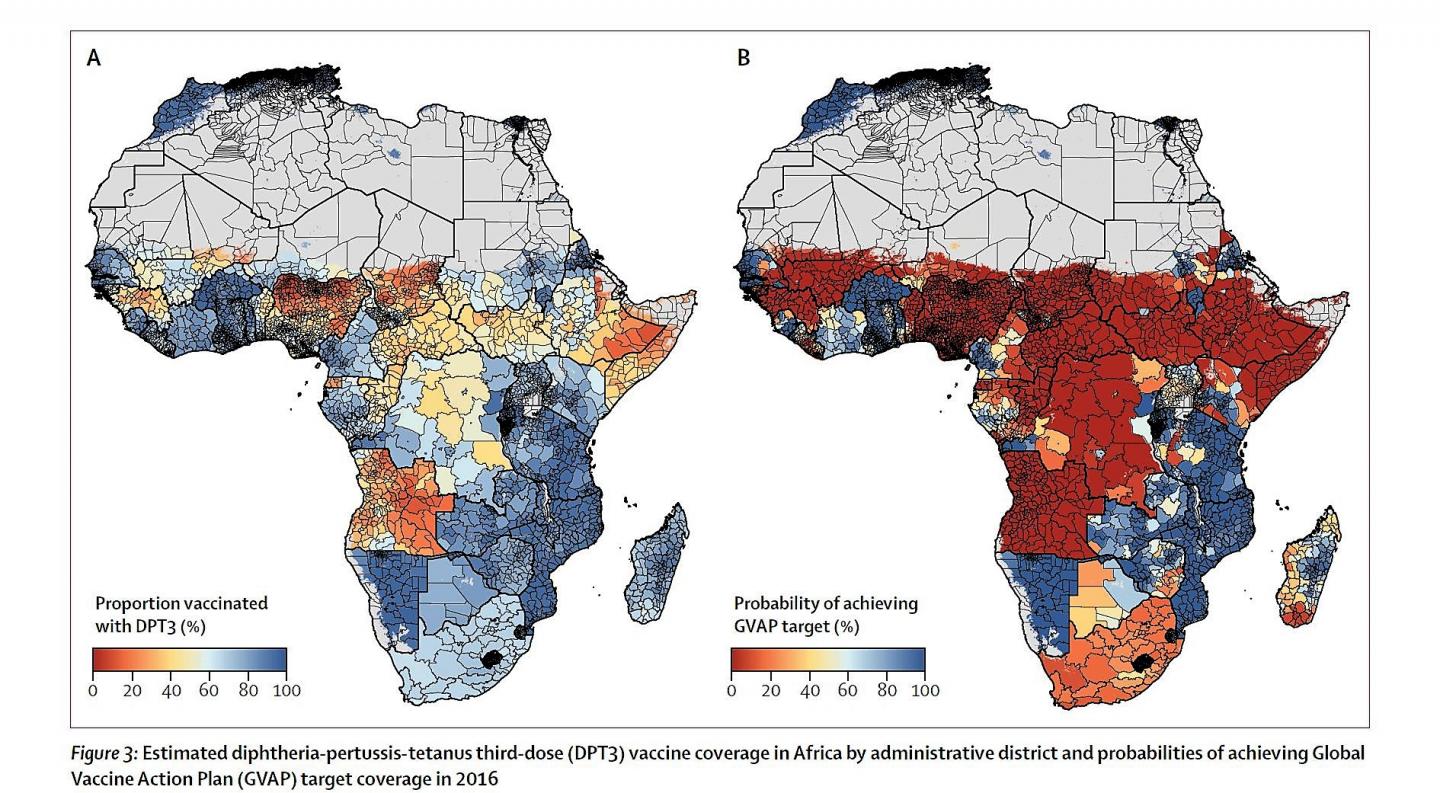New study published in The Lancet helps identify where to improve vaccine delivery

Credit: Institute for Health Metrics and Evaluation
SEATTLE – Many African nations have made substantial progress in vaccinating children against life-threatening diseases, however, within countries wide discrepancies remain, according to a new scientific study.
The proportion of children receiving the full infant series of three vaccinations against diphtheria, pertussis and tetanus (DPT3) increased in almost three quarters of districts in Africa between 2000 and 2016. In 29 of 52 nations studied, however, coverage with DPT3 varied by more than 25% at the district level, highlighting substantial variation within countries.
The study, funded by the Bill & Melinda Gates Foundation and conducted by the Institute for Health Metrics and Evaluation at the University of Washington, was published in the international medical journal The Lancet.
“Despite substantial gains in coverage, progress was far from universal,” said Dr. Jonathan Mosser, the lead author on the study. “Routine childhood vaccinations are among the most successful and cost-effective public health interventions, substantially contributing to children living beyond their fifth birthdays. We continue to see wide areas of low coverage at the local level, however, illustrating that targeted improvements are needed to ensure that all children have access to lifesaving immunizations.”
The study, “Mapping diphtheria-pertussis-tetanus vaccine coverage in Africa, 2000-2016: a spatial and temporal modelling study,” maps nations in fine-scale, 5×5 kilometer increments, so that health officials nationally and locally can identify gaps in vaccine coverage and target interventions with precision, tailoring health policy decisions at local levels.
Using data from nearly 900,000 children, this analysis provides the first annual estimates of childhood DPT3 coverage across the entire African continent. It measures each community against the Global Vaccine Action Plan benchmark of reaching 90% national coverage and 80% in every district. These goals were established in 2012 by WHO member nations, as well as other organizations, including UNICEF, the Gates Foundation, and Gavi, the Vaccine Alliance, a public-private health partnership committed to increasing access to immunizations in poor countries.
Of the 52 countries studied, only Morocco and Rwanda are estimated to have already met the district-level goal of 80% coverage. In contrast, on the local level, areas of DPT3 coverage at or below 25% were found in several countries, including Nigeria, Chad, Ethiopia, Somalia, and Angola. Moreover, dropout rates exceeding 25% were identified in portions of Nigeria, Angola, Chad, Mali, Guinea, Liberia, Equatorial Guinea, Central African Republic, South Africa, Somalia, and Ethiopia.
“National estimates can mask subnational pockets of low coverage, leaving children in at risk for preventable diseases and death,” Mosser said. “Our study offers insights for nations’ health ministers and other decision makers to better understand local patterns of vaccine coverage and to identify where to improve vaccine delivery systems.”
An official with the Gates Foundation underscored the value of the study and its geospatial mapping techniques.
“We know that there are many children not getting the vaccines they need, but there’s a real lack of detail about where those children are,” said Violaine Mitchell, director of Vaccine Delivery at the Bill & Melinda Gates Foundation. “These maps are a critical step forward in revealing important detail on where the unvaccinated children are so that tailored strategies can be developed to reach them and truly achieve equitable coverage.”
###
The study is the latest in a series of IHME papers as part of the institute’s Local Burden of Disease (LBD) project, which produces estimates of health outcomes and related measures covering entire continents at a fine resolution. The project is seeking additional collaborators, including academics, researchers and others, to contribute data and to evaluate draft papers. For more information, please contact the LBD Engagement Team at [email protected].
Media contacts:
IHME: Dean Owen, +1-206-897-2858 (office); +1-206-434-5630 (mobile); [email protected]
About the Institute for Health Metrics and Evaluation
The Institute for Health Metrics and Evaluation (IHME) is an independent global health research organization at the University of Washington that provides rigorous and comparable measurement of the world’s most important health problems and evaluates the strategies used to address them. IHME makes this information widely available so that policymakers have the evidence they need to make informed decisions about how to allocate resources to improve population health.
About the Local Burden of Disease project
The Local Burden of Disease project at IHME aims to produce estimates of health outcomes and related measures that cover entire continents, but to do so at a very fine, local resolution. Such estimates allow decision-makers to target resources and health interventions precisely, so that health policy decisions can be tailored for local areas rather than entire countries. Combining local detail with broad coverage – producing 5×5 kilometer estimates for entire continents and, eventually, the world – would give health officials everywhere the tools to make locally informed decisions and, in the process, help all people live longer, healthier lives. The Local Burden of Disease project is led by Dr. Simon I. Hay, Professor of Health Metrics Sciences at the University of Washington and Director of Geospatial Science at IHME.
Media Contact
Dean R Owen
[email protected]
Original Source
http://www.
Related Journal Article
http://dx.




